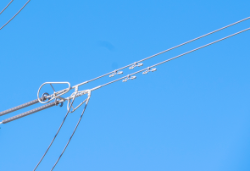- International Women's Day
27 Mar, 2025 - Compression Fitting Failures
14 Mar, 2025 - Understanding How Conduit Sealants Perform in the Presence of Fire
6 Feb, 2025 - Employee of the Year 2024
15 Jan, 2025 - National Work Safety Month 2024
9 Dec, 2024 - Wildlife Mitigation Products
21 Oct, 2024 - Lou's 25th Anniversary
14 Oct, 2024 - TEN HQ is moving
2 Sep, 2024 - Highlights from TENNET 2024
1 Jul, 2024 - The Zero Splice Rule
28 Jun, 2024 - ALE - ClampStar Conductor Repair
31 May, 2024 - System Resilience - Polywater
2 May, 2024
An Introduction to Vibration control8 May, 2023 An Introduction to Vibration control Vibration dampers are typically installed along the length of the transmission line at regular intervals. They work by absorbing some of the energy of the oscillations, which reduces the amplitude of the vibrations and the stress on the conductors. This helps to prevent damage to the conductors and ensures the safe and reliable operation of the transmission line. In addition to improving the safety and reliability of the transmission line, vibration dampers can also help to reduce the noise generated by the conductors as they vibrate in the wind. This can be especially important in urban areas where transmission lines are located close to homes and businesses. Selecting the correct size and quantity of dampers for a transmission line section depends on several factors, including the length of the conductor between two supports (Tower or Pole), the type of conductors used, the anticipated wind conditions, and the desired level of vibration reduction. Guide to Damper Selection Determine the length of the transmission line section: Determine the type and size of conductors used: Determine the anticipated wind conditions: Determine the desired level of vibration reduction: In general, it is recommended to consult with a vibration damper manufacturer or a professional engineer with experience in transmission line design to determine the correct size and quantity of dampers needed for a specific transmission line section. They consider all the factors listed above and provide a customised solution for your specific needs. Maclean Power has developed special recommendation software for the type and installation of 4D series vibration dampers. The software is preloaded with over 400 hundred conductors with standard line tension calculated at 20% CBL. As manufacturers of the dampers, they have collected information from a multitude of tests made on the dampers and from field tests they carried-out on lines where the dampers are installed. Vibration analysis has been performed in consequence of these tests and the effectiveness of damping has been determined. Wind power, damper power and self-damping of the conductor are all considered. For Damper selection, installation and placement recommendations, please contact TEN for a Damping Proposal Form or download a copy here.
|



|



